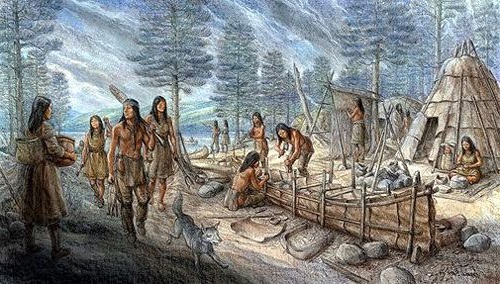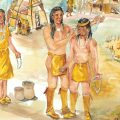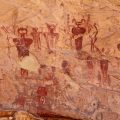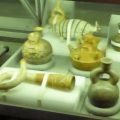
( – promoted by navajo)
At the time of the first European contact in the sixteenth century, there were an estimated 30,000 Abenaki people living in northern New England and the Maritime Provinces. The Abenaki – a corruption of the Innu (a neighboring tribe) word which refers to “the people of the dawn land” – are a group of loosely related Algonquian-speaking people who have lived in the New England area for thousands of years. The Abenaki include the Sokoki on the middle and upper Connecticut River, the Cowasuck farther upriver, the Missisquoi on Lake Champlain, the Pennacook in New Hampshire’s Merrimack Valley, the Pigwacket in the White Mountains, the Androscoggin of western Maine, the Penobscot, Wawenock, and Kennebec of Maine.
This diary is going to explore Maine’s ancient American Indians.
In 8500 BCE, Indian people established a seasonal site at Vail for killing caribou. The caribou were killed along a sandy patch of ground near the river and then the animals were processed for hide, meat, and marrow. The hunters maintained their camp across the river from the kill site.
Indian hunters at this time were using fluted points with deep concave bases which are similar to those used by the people at the Debert site in Nova Scotia. While the nearest suitable source for stone for making tools was about 25 kilometers away, the hunters and food processors at Vail were using stone tools which come from more distant quarries in Vermont, New York, and Pennsylvania.
The people living at the Vail site were using tents which measured about 4.5 by 6 meters (approximately 15 by 20 feet).
By 5000 BCE the Indian people in Maine and the Canadian Maritime Provinces had developed a way of life that archaeologists call the Maritime Archaic Tradition. Subsistence activities focused on sea mammals such as seals (harp, ringed, harbor, gray, and bearded seals), walrus, porpoises, and whales. They were also taking fish and sea birds. In addition, they were also harpooning swordfish.
During the early spring, the Maritime Archaic people would be on or near the coast where they could easily take the sea mammals on the pack and landfast ice. In the summer, the sea mammals are less available, but the people stayed on the coast to fish-particularly for Atlantic salmon-and to take birds. At the first snow, they withdrew from the coast to inland hunting locations where they hunted caribou, moose, and elk.
Indian people in Maine at this time were making axes, adzes, and gouges from stone which they used in their woodworking industry. This woodworking included making frames for shelters, weapon and tool handles, boats (including dugout canoes), and wooden bowls.
Spirituality at this time included hunting magic (evidenced in the wearing of charms and amulets) and a well-developed burial ceremonialism. Burials involved the use of red ochre as well as many grave offerings. Graves tended to be oriented toward the east.
In south-central Maine, a period designated by archaeologists as the Moorehead Phase began about 3000 BCE. This time period was characterized by cemeteries and ceremonialism. At this time, the people were making stone tools which were intended for ceremonial use rather than everyday use. One of the most striking tools they were making were ground-slate bayonets. They were also making animal effigies.
The first evidence of the use of pottery in Maine is found about 2,000 years ago. At this time, the Indian people on Deer Island were making pottery. The pottery which they made tended to be thin, hard, and generally well made. This suggests that the ceramic techniques or even the pots themselves were introduced as a developed complex from the drainages to the southwest.
Expanded trade networks are seen 1,000 years ago at which time the Maine Indians were using arrowheads and scrapers made from chert from Ramah Bay on the north Labrador coast, from northern Quebec, and from western New York. They were obtaining jasper from Pennsylvania and chalcedony from Nova Scotia. They were also getting copper from western Nova Scotia.
By the time the Europeans began having regular contact with Maine’s Indians 500 years later, agriculture focused on corns, beans, and squash was being practiced in the area south of the Saco River. The Indian nations to the north of the Saco River were still following a hunting, gathering, and fishing way of life.




Leave a Reply